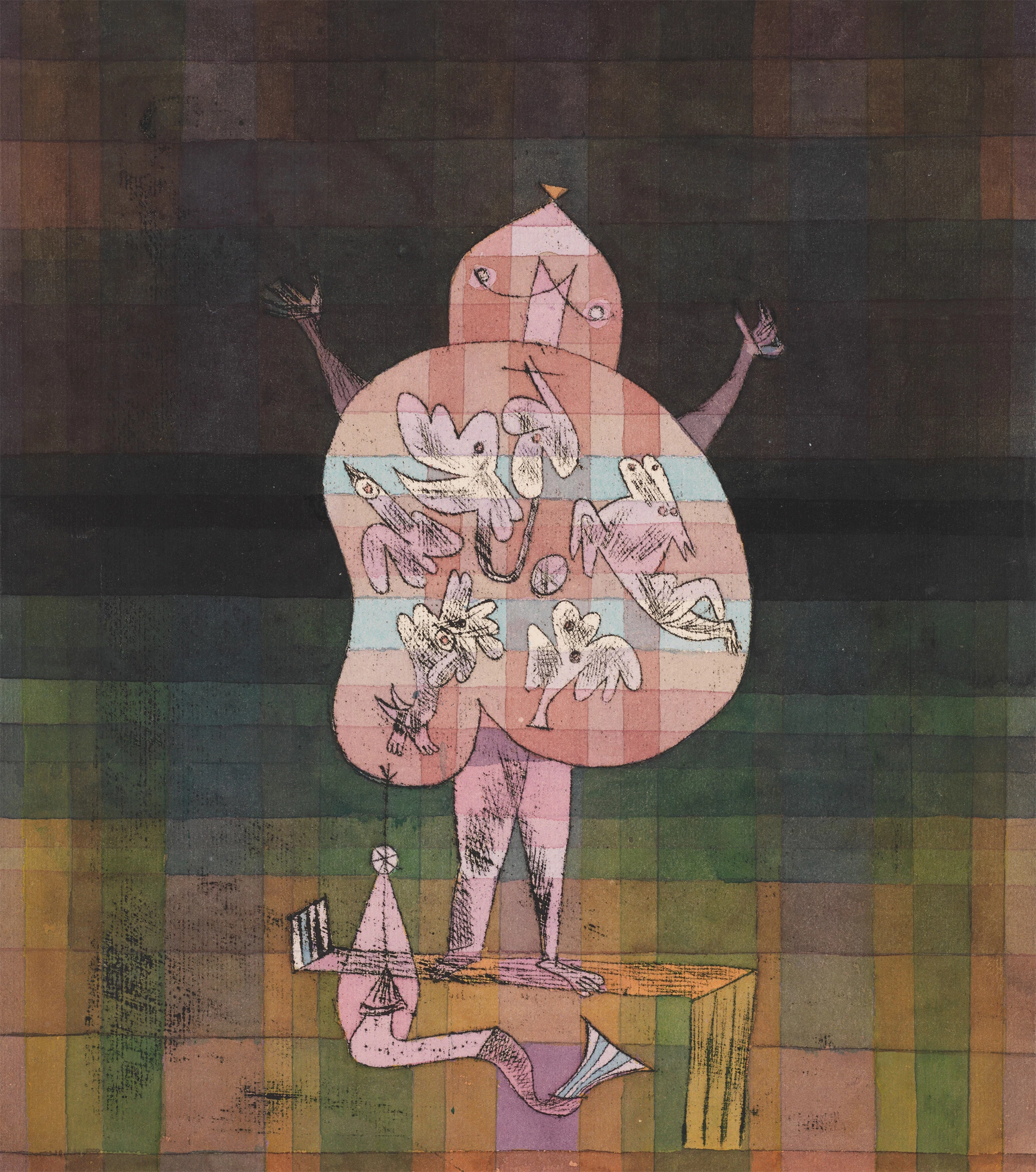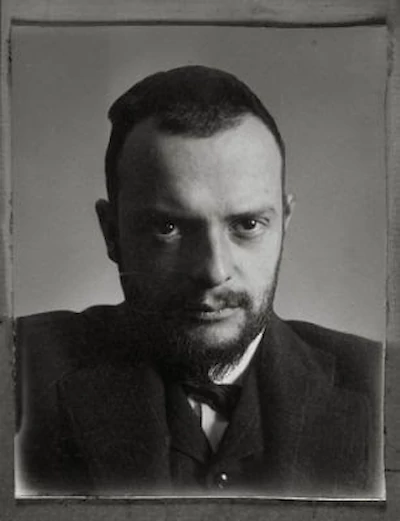

Paul Klee
"A long struggle lies in store for me in this field of color"
1879 – 1940Art does not reproduce the visible but makes visible. The very nature of graphic art lures us to abstraction, readily and with reason. It gives the schematic fairytale quality of the imaginary and expresses it with great precision. The purer the graphic work, that is, the more emphasis it puts on the basic formal elements, the less well-suited it will be to the realistic representation of visible things.
Formal elements of graphic art are: points, and linear, plane, and spatial energies. A plane element which is not composed from subordinate units is, for example, an energy, produced by the stroke of a broad-edged pencil, uniform or modulated. A spatial element, for example, is a misty, cloud-like spot made by a full brush, usually uneven in its intensity.
Let us develop: let us draw up a topographical plan and take a little journey to the land of better understanding. The first act of movement (line) takes us far beyond the dead point. After a short while we stop to get our breath (interrupted line or, if we stop several times, an articulated line). And now a glance back to see how far we have come (counter-movement). We consider the road in this direction and in that (bundles of lines). A river is in the way, we use a boat (wavy motion). Farther upstream we should have found a bridge (series of arches). On the other side we meet a man of like mind, who also wants to go where better understanding is to be found. At first we are so delighted that we agree (convergence), but little by little differences arise (two separate lines are drawn). A certain agitation on both sides (expression, dynamics, and psyche of the line).
We cross an unploughed field (area traversed by lines), then a dense wood. He gets lost, searches, and once even describes the classical movement of a running dog. I am no longer quite calm either: another river with fog (spatial element) over it But soon the fog lifts. Some basket-weavers are returning . home with their carts (the wheel). Accompanied by a child with the merriest curls (spiral movement). Later it grows dark and sultry (spatial element). A flash of lightning on the horizon (zigzag line). Over us there are still stars (field of points). Soon we come to our original lodging. Before we fall asleep, a number of memories come back to us, for a short trip of this kind leaves us full of impressions.
All sorts of lines. Spots. Dots. Smooth surfaces. Dotted surfaces, shaded surfaces. Wavy movement. Constricted, articulated movement. Countermovement. Network and weaving. Brickwork, fish-scales. Solo, Chorus. A line losing itself, a line growing stronger (dynamics).
The happy equanimity of the first stretch, then the inhibitions, the nervousness! Restrained trembling, the caress of hopeful breezes. Before the storm, the gadflies’ attack. The fury, the murder. The good cause a guiding thread, even in the thick of twilight. The lightning shaped like the fever curve. Of a sick child ... Long ago.
I have mentioned elements of graphic representation which should be visible in the work. This must not be taken to mean that a work should consist solely of elements. The elements should produce forms, but without losing their own identity. Preserving it.
Usually several of them will have to stand together to produce forms, or objects, or other secondary things, Planes produced by lines entering into relations one with another (e.g. as one sees stormy watercourses) or spatial structures produced by energies related to the third dimension (swarming fishes).
Through such enrichment of the formal symphony the possibilities of variation, and with them the ideal opportunities for expression, grow beyond number.
In the beginning is the act; yes, but above it is the idea. And since infinity has no definite beginning, but is circular and beginningless, the idea may be regarded as the more basic. In the beginning was the word, as Luther translated it,
All becoming is based on movement. In Lessing’s Laocoon, on which we wasted a certain amount of intellectual effort in our younger days, a good deal of fuss is made about the difference between temporal and spatial art. But on closer scrutiny the fuss
turns out to be mere learned foolishness. For space itself is a temporal concept.
When a point turns into movement and line - that takes time. Or when a line is displaced to form a plane. And the same is true of the movement of planes into spaces.
Does a picture come into being all at once? No, it is built up piece by piece, the same as a house.
And what about the beholder: does he finish with a work all at once? (Often yes, unfortunately.)
Didn’t Feuerbach say: For the understanding of a picture, a chair is needed? Why a chair? To prevent the legs, as they tire, from interfering with the mind. Legs get tired from long standing. The space in which we move belongs to time, character belongs to movement. Only the dead point is timeless. And likewise in the universe, movement is the basis of everything. (Where do they get the energy? That is the idie question of a disappointed man.) Peace on earth is an accidental congestion of matter. To take this congestion as basic is mistaken.
The Biblical story of Creation is a good parable for motion. The work of art, too, is first of all genesis; it is never experienced purely as a result.
A certain fire flares up; it is conducted through the hand, flows to the picture 4 and there bursts into a spark, closing the circle whence it came: back into the eye and farther (back to one of the origins of movement, of volition, of idea). What the beholder does is temporal too. The eye is so organized that it conveys the parts successively into the crucible of vision, and in order to adjust itself to a new fragment has to leave the old one. After a while the beholder, like the artist, stops and goes away. If it strikes him as worth while - again like the artist - he returns.
In the work of art, paths are laid out for the beholder’s eye, which gropes like a grazing beast (in music, as everyone knows, there are channels leading to the ear - in drama we have both varieties). The pictorial work springs from movement, it is itself fixated movement, and it is grasped in movement (eye muscles).
Formerly, artists depicted things that were to be seen on the earth, things people liked to see or would like to have seen. Now the relativity of visible things 1 is made clear, the belief expressed that the visible is only an isolated case taken from the universe and that there are more truths unseen than seen. Things appear enlarged and multiplied and often seem to contradict the rational experience of yesterday. An effort is made to give concrete form to the accidental.
The inclusion of concepts of good and evil creates an ethic. Evil should not be an enemy who triumphs or who shames us, but a power contributing to the whole. A part of conception and development. The primordial-masculine (evil, stimulating, passionate) and primordial-feminine (good, growing, tranquil) together producing a state of ethical stability.
To this corresponds a simultaneous union of forms, movement and countermovement, or to put it more naively, of objective contrasts (the use of disjunct color contrasts, as by Delaunay). Every energy requires its complement to bring itself to rest outside the field of force. Abstract formal elements are put together like numbers and letters to make concrete beings or abstract things; in the end a formal cosmos is achieved, so much like the Creation that a mere breath suffices to transform religion into act.
A few examples: A man of antiquity sailing a boat, quite content and enjoying the ingenious comfort of the contrivance. The ancients represent the scene accordingly. And now: What a modern man experiences as he walks across the deck of a steamer:
Result: an interplay of movements in the universe, at their centre the ‘I’ on the ship.
An apple tree in blossom, the roots, the rising sap, the trunk, a cross section with annual rings, the blossom, its structure, its sexual functions, the fruit, the core and seeds. An interplay of states of growth.
A sleeping man, the circulation of his blood, the measured breathing of the lungs, the delicate function of the kidneys, in his head a world of dreams, related to the powers of fate. An interplay of functions, united in rest.
The relation of art to creation is symbolic. Art is an example, just as the earthly is an example of the cosmic.
The liberation of the elements, their arrangement in subsidiary groups, simultaneous destruction and construction towards the whole, pictorial polyphony, the creation of rest through the equipoise of motion: all these are lofty aspects of the question of form, crucial to formal wisdom; but they are not yet art in the highest sphere. A final secret stands behind all our shifting views, and the light of intellect gutters and goes out.
— First published in ‘Tribune der Kunst und Zeit’ in 1920.